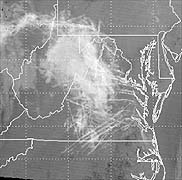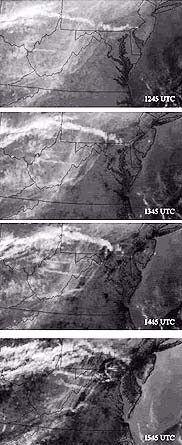A satellite
image from Jan. 26 shows the typical maze of contrails in the Washington
area.
NASA

The New York Times October 30, 2001
The suspension of flights after the Sept. 11 attacks has provided scientists with a rare chance to improve their analysis of how aviation affects climate.
When the air above 25,000 feet is humid, the skies are laced with drifting streaks called contrails, created as ice crystals form on the exhaust plumes of hundreds of jets. The wind and gravity disperse the narrow contrails, which form wispy cirrus clouds.
This veil-like type of cloud allows sunlight in to warm the earth and traps some of the rising heat before it can radiate into space. This effect is thought to add slightly to a warming trend that scientists say is caused by heat-trapping gases released when fossil fuels are burned. The ideal way to measure such an effect would be to look at the same piece of sky when air traffic is heavy and when it is absent, said Dr. Patrick Minnis, a senior research scientist at the National Aeronautics and Space Administration's Langley Research Center in Hampton, Va.
But the skies are never devoid of aircraft. At least that was the case until Sept. 11. Since then, Dr. Minnis and others have been reviewing satellite images of clouds and contrails. Near dusk on the 11th, the only contrails in the East were three streaks heading from Nebraska to Washington, almost certainly Air Force One and its escort taking President Bush from Offutt Air Force Base to the White House, Dr. Minnis said. Everything matched, he said: "the trajectory and timing and the fact that nothing else was flying."
NASA requested that
the image of the president's jet not be published, citing security risks.
The most valuable data were collected the next day. Only nine military
flights crossed a region from Ohio to Virginia, an area normally cloaked
in cirrus clouds from the 700 to 800 jets crossing daily, Dr. Minnis said.
With those images, his team was able to chart precisely how those nine
threadlike contrails fanned out over five hours to form a shield of cirrus
clouds covering 24,000 square miles.
Dr. Minnis provided other satellite views of the area on a more typical day, Jan. 26, which show a broad area of clouds fringed by fading contrails. Having an isolated view of individual contrails spreading into clouds should allow scientists to refine computer systems that scan satellite images for contrails' effects, he said. Ultimately, he said, the observations in September will refine computer models of the overall effect of aviation on climate.
NASA
